Complexation and Protein Binding: Physical Pharmaceutics-I (Unit IV) PDF
Download essential PDF notes for Unit IV of Physical Pharmaceutics-I (BP302T) covering "Complexation and Protein Binding." This document introduces fundamental concepts vital for understanding drug interactions in pharmaceutical systems.
The notes begin with an introduction to complexation, defining it as the process of characterization of covalent or non-covalent interactions between two or more compounds. It clarifies the role of a ligand as a molecule that interacts with another molecule (the drug) to form a complex. Special emphasis is given to coordination complexes, explaining them as products of Lewis acid-base reactions where neutral molecules or anions (ligands) bond to a central metal atom or ion by coordinate covalent bonds.
This resource provides a clear foundation for grasping how these interactions influence drug behavior, stability, and efficacy in the body and in formulation.
Keywords: Complexation and Protein Binding PDF, BP302T, Physical Pharmaceutics-I Unit 4, complex formation, ligand, coordination complex, protein binding, drug action, Lewis acid-base, DuloMix, Sildes By DuloMix, free pharmacy notes.
Complexation and Protein Binding: A Comprehensive Study for Physical Pharmaceutics-I (Unit IV, BP302T)
Complexation and protein binding are critical phenomena in pharmaceutical sciences that profoundly impact a drug's solubility, stability, distribution, metabolism, and therapeutic efficacy. Unit IV of Physical Pharmaceutics-I (BP302T) provides a detailed exploration of these interactions.
Introduction to Complexation
Complexation is the reversible association between two or more molecules to form a new chemical entity known as a complex. This process involves various types of interactions, including covalent, non-covalent (e.g., hydrogen bonding, van der Waals forces), electrostatic, and hydrophobic interactions.
In the context of complexation, a ligand is a molecule, ion, or atom that binds to a central atom, usually a metal ion, to form a complex. However, in a broader sense, in pharmaceutical systems, a drug molecule can act as a ligand, interacting with other small molecules (e.g., cyclodextrins, excipients) or macromolecules (e.g., proteins) to form a complex. These interactions are crucial for drug delivery and understanding drug behavior.
A specific type of complex is a coordination complex, which is typically the product of a Lewis acid-base reaction. Here, neutral molecules or anions (termed ligands) donate electron pairs to a central metal atom or ion, forming coordinate covalent bonds. Examples include metal-ligand complexes that can influence the stability or activity of certain drugs (e.g., tetracycline chelating with metal ions).
Classification of Complexation
Complexes are generally classified based on their nature:
- Metal Ion Complexes: Involve a central metal ion (Lewis acid) and ligands (Lewis bases) that donate electron pairs (e.g., chelates).
- Organic Molecular Complexes: Formed between organic molecules through intermolecular forces, not covalent bonds. Examples include:
- Charge Transfer Complexes: Involve electron transfer from a donor to an acceptor molecule.
- Inclusion Complexes: One molecule (guest) is entirely or partially entrapped within the cavity of another molecule (host) (e.g., cyclodextrin complexes, clathrates).
- Picric Acid Complexes: Formed between picric acid and various organic compounds.
Applications of Complexation in Pharmacy
The practical significance of complexation in pharmaceutics is immense:
- Increased Solubility: Poorly water-soluble drugs can form soluble complexes (e.g., with cyclodextrins) to improve dissolution.
- Enhanced Stability: Complexation can protect sensitive drugs from degradation (e.g., oxidation, hydrolysis).
- Masking Taste/Odor: Complexing an objectionable drug can mask its unpleasant sensory properties.
- Reduced Toxicity: By altering drug distribution or chelating toxic ions (e.g., EDTA for heavy metal poisoning).
- Controlled Release: Modifying drug release kinetics by forming complexes.
- Improved Bioavailability: Through enhanced solubility or stability.
Protein Binding
Protein binding is a critical aspect of pharmacokinetics. It refers to the reversible non-covalent interaction of drugs with proteins, primarily plasma proteins like albumin, α1-acid glycoprotein, and lipoproteins, as well as tissue proteins. Only the unbound (free) fraction of a drug is pharmacologically active and capable of diffusing across membranes, interacting with receptors, being metabolized, or excreted.
The extent of protein binding influences a drug's:
- Distribution: Highly bound drugs tend to have a smaller volume of distribution.
- Elimination: Protein binding can reduce the rate of glomerular filtration and hepatic metabolism.
- Drug-Drug Interactions: Competition for binding sites can displace one drug by another, leading to increased free concentration and potential toxicity.
Complexation and Drug Action
The formation of complexes can directly influence drug action. For instance, complexation can:
- Inactivate a Drug: If the complexed form cannot bind to its receptor.
- Activate a Prodrug: If the active drug is released upon complex dissociation.
- Alter Duration of Action: By affecting the rate of drug release or elimination.
- Provide a Therapeutic Effect: As in chelation therapy, where a chelating agent complexes with toxic metal ions for their removal from the body.
Crystalline Structures and Thermodynamic Treatment of Stability Constants
The physical state and arrangement of molecules in a complex, its crystalline structure, are studied using techniques like X-ray crystallography. This provides insights into bond lengths, angles, and intermolecular forces, which dictate the complex's properties.
The strength of a complex is quantified by its stability constant (K), which reflects the equilibrium between the free components and the complex. A higher K value indicates a more stable complex. The thermodynamic treatment of stability constants involves the application of Gibbs free energy (ΔG°), enthalpy (ΔH°), and entropy (ΔS°) changes. These thermodynamic parameters help in understanding the driving forces (e.g., entropic, enthalpic) behind complex formation and predicting their behavior under different environmental conditions, which is crucial for formulation development and storage.
In conclusion, understanding complexation and protein binding mechanisms is indispensable for pharmaceutical scientists. These concepts are fundamental to rational drug design, optimization of drug delivery systems, predicting pharmacokinetic behavior, and ensuring the safety and efficacy of therapeutic agents.
Info!
If you are the copyright owner of this document and want to report it, please visit the copyright infringement notice page to submit a report.

